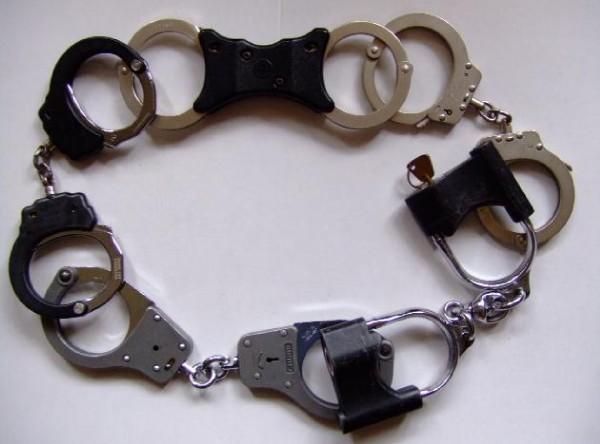Getting cuffed in the UK
By Mikeintightpants
If you ever get apprehended here in the UK in circumstances where the officer deems it necessary to apply handcuffs (or better still, if you meet up with a friendly cop!), you’ll find yourself wearing one of the sets of cuffs shown in this photo that I’ve assembled from items in my collection.
 Clockwise from the top, the cuffs are: Hiatt Speedcuffs, Hiatt chain cuffs, Chubb Escort cuffs, Chubb Arrest cuffs, ASP chain cuffs.
Clockwise from the top, the cuffs are: Hiatt Speedcuffs, Hiatt chain cuffs, Chubb Escort cuffs, Chubb Arrest cuffs, ASP chain cuffs.
Hiatt Speedcuffs (model 2103) are the cuffs used by most of our uniformed cops here in the UK. They’re rigid cuffs resulting in considerable restriction of arm movement and allow for easy “stacking” of the hands either in front or behind the back. There are several different designs of carrying pouch which fit onto a duty belt. Most universal cuff keys are suitable.
Hiatt chain cuffs (model 2010) are similar to regular chain cuffs, the main difference being that they’re slightly smaller than standard swing-through cuffs such as Smith & Wesson 100’s and they keep the hands considerably closer together. These have effectively been superseded by the Hiatt Speedcuffs, though many officers still carry a pair as back-up. There are several different designs of carrying pouch which fit onto a duty belt, although some officers carry them loose in their back pocket. Most universal cuff keys are suitable.
Chubb Escort cuffs (model 1K52) – a.k.a. Chubb Transport cuffs. These cuffs are used by the UK prison service for transporting prisoners and are extremely expensive. They are not issued to police patrol officers and not used by any of our police forces. I am not aware of any carrying pouches for these as they are not carried on duty as a matter of course but applied in prisons and courts for prisoner transportation to another secure area where they are removed. The cuffs are not swing-through and have 3 locking positions to accommodate smaller wrists. In addition, sets of metal inserts are available that further restrict the internal diameter of the bracelets; the inserts come in 3 different sizes, thus giving overall the possibility of 9 different internal diameters for each cuff. High security cuffs with either 9 or 10 lever locks requiring keys cut from restricted blanks. Cuffs can be keyed individually for each pair (there are millions of possible combinations) or they can be keyed in batches to suit individual departments.
Chubb Arrest cuffs (model 1K70) – a.k.a. Chubb Detainer cuffs. Secure swing-through cuffs but very expensive and allow the hands to be much further apart than standard cuffs such as Smith & Wesson 100’s. Until recently they were standard issue to police officers in our Sussex police force but because of cost, new entrants are now issued with ASP chain cuffs (see below). Universal cuff key does not work with these cuffs which require a special key. The keys can be coded to any one of approximately 20 different combinations. Carried on duty belt in leather or nylon pouch.
ASP chain cuffs – these cuffs are now very much in evidence as being used by law enforcement agencies worldwide and, yes, here in England too. Our Sussex police have now moved their allegiance from Chubb Arrest cuffs (see above) to these ASP chain cuffs, purely for reasons of cost. These cuffs are applied in exactly the same way as other standard chain cuffs, work with a universal cuff key and are usually carried on the duty belt in a suitable pouch or on a cuff strap.
Hiatt hinged cuffs (model 2050) – when I assembled the cuffs for the above photo I forgot to include the Hiatt hinged cuffs that are used by just one of our UK police forces – Northamptonshire – who prefer to use these hinged beauties instead of rigid Speedcuffs. Officers are issued with 2 pairs that are carried in pouches in their hi-viz jacket. Universal key, once again.
Incidentally, since the demise of Hiatt as a handcuff manufacturer a few years ago, their premises and manufacturing facilities were taken over by TCH who now market virtually identical products under their own name, albeit with different model numbers. Therefore, references above to Hiatt should also be read as including TCH.
Thanks, Mikeintightpants for the picture and information!

